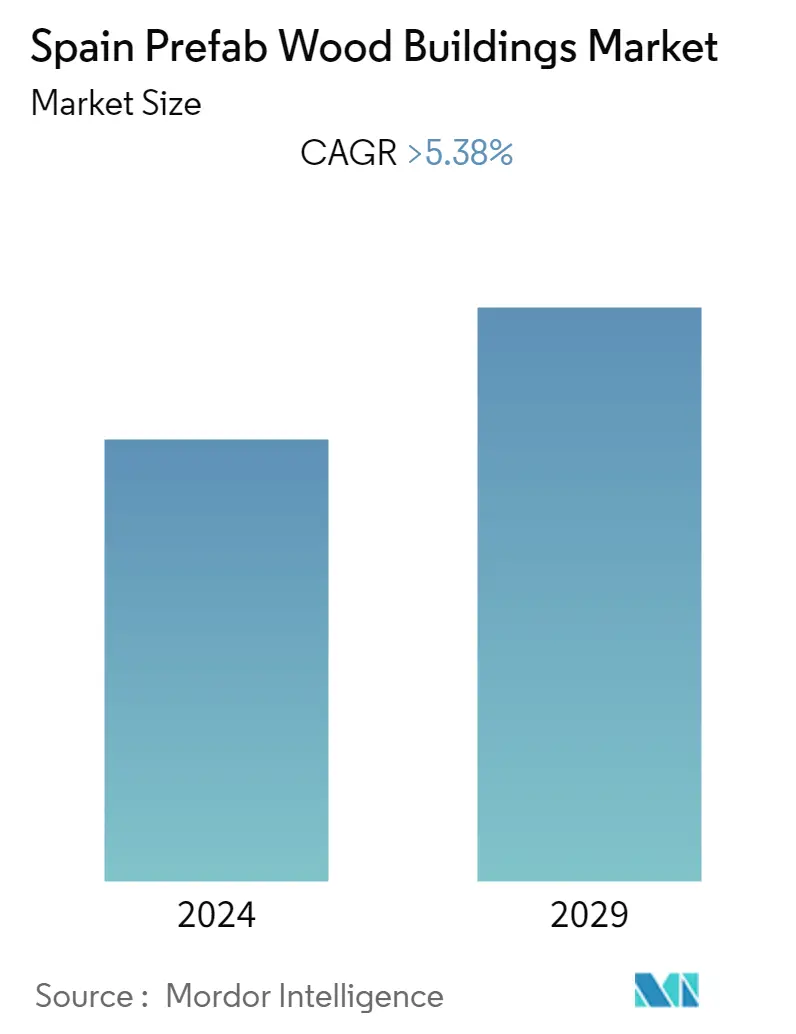Market Size of Spain Prefab Wood Buildings Industry

| Study Period | 2020 - 2029 |
| Base Year For Estimation | 2023 |
| Forecast Data Period | 2024 - 2029 |
| Historical Data Period | 2020 - 2022 |
| CAGR | > 5.38 % |
| Market Concentration | Medium |
Major Players
*Disclaimer: Major Players sorted in no particular order |
Spain Prefab Wood Buildings Market Analysis
The size of the Spain Prefab Wood Buildings Market is USD 1.02 billion in the current year and is anticipated to register a CAGR of over 5.38% during the forecast period. The market is driven by huge investments in prefabricated buildings. Furthermore, the market is driven by the advanced technology involved.
- The government expects to invest significant sums of money to address the affordable housing situation throughout the anticipated timeframe as the housing crisis intensifies. In its 20,000 Housing Plan, the Ministry of Transport, Mobility, and Urban Agenda seek to improve the availability of public housing for low-cost rent. There are currently 642,500 floors of public housing in Spain, which makes up only 2.5% of all housing. By 2030, the government hopes to raise this to 8% with this plan. To do this, the Ministry has invested about USD 62 million, which when added to the investments made by the Autonomous Communities and City Councils, totals USD 370 million.
- Demand growth has been attributed mostly to the housing market and the construction sector. Sales of wood house frames may be hampered by the availability of popular replacements like cement and steel. In the Spanish building sector, prefabricated homes are rising in popularity. In Spain, the number of businesses that specialize in modular housing has increased dramatically in recent years, and even huge developers have started to industrialize. If prefabricated timber construction is gaining popularity, it's for good reason. Aside from wood's unique properties (low carbon footprint, possibility of local short supply chain, etc.), prefabrication now means that constructing a timber building transitions from an on-site artisanal effort to an off-site industrial production with all of the benefits that entail. Factory-made production, with less risk than on-site construction, makes it easier to control costs and save time. Because the building is built in modules in a factory, residents living near the construction site often experience less noise and pollution. Furthermore, timber waste from construction sites (renovation, demolition) has a 75% recycling and energy recovery rate.
- To thrive in a dynamic environment, you must constantly experiment and think outside the box. In recent years, there has been an increase in creative problem-solving in the field of pre-engineered buildings (PEB). The fundamental steel framework for prefabricated steel buildings is made up of built-up sections, hot-rolled sections, and cold-formed components, while the roof and wall cladding are made up of single skin sheeting with extra insulation or insulated sandwich panels, respectively. These Pre-Engineered Steel Buildings' structural components can be customised to meet a variety of requirements. It has many advantages over more traditional structures for any low-rise construction. The various submarkets that comprise the international prefabricated building industry are defined by regional, structural, and functional specialisations.
Spain Prefab Wood Buildings Industry Segmentation
Prefabricated wood construction kits, similar to life-sized Legos, are constructed out of prefabricated components that are supplied and installed on-site. This is most commonly accomplished by the use of prefabricated panels that may create complete portions of a building, such as roofing components or structure (ceiling, decking, and beams), building structure (wall panels, beams, columns, and shear panelling), and even glazing packages. A complete background analysis of the Spain Prefab Wood Buildings Market, including the assessment of the economy and contribution of sectors in the economy, market overview, market size estimation for key segments, and emerging trends in the market segments, market dynamics, and geographical trends, and COVID-19 impact is included in the report.
The Spain Prefab Wood Buildings Market is segmented By Panel Systems (Cross-laminated timber (CLT) panels, Nail-laminated timber (NLT) panels, Dowel-laminated timber (DLT) panels, and Glue-laminated timber (GLT) columns and beams), and By Application (Single Family Residential, Multi-family Residential, Office, and Hospitality). The report offers market size and forecasts in value (USD billion) for all the above segments.
| Panel Systems | |
| Cross-laminated timber (CLT) panels | |
| Nail-laminated timber (NLT) panels | |
| Dowel-laminated timber (DLT) panels | |
| Glue-laminated timber (GLT) columns and beams |
| Application | |
| Single Family Residential | |
| Multi-family Residential | |
| Office | |
| Hospitality | |
| Others |
Spain Prefab Wood Buildings Market Size Summary
The Spain Prefab Wood Buildings Market is experiencing significant growth, driven by substantial investments in prefabricated construction and advanced technological innovations. The government's focus on addressing the affordable housing crisis through initiatives like the 20,000 Housing Plan is a key factor propelling the market. This plan aims to increase the availability of public housing, thereby boosting demand for cost-effective and efficient building solutions. The popularity of prefabricated timber construction is rising, as it offers numerous advantages over traditional methods, such as reduced carbon footprint, cost control, and minimized on-site disruption. The shift from artisanal on-site construction to industrial off-site production is enhancing process efficiency, sustainability, and quality, making prefab wood buildings an attractive option for both residential and commercial projects.
The market is characterized by a growing number of specialized companies and increased industrialization by major developers, contributing to the sector's expansion. Despite competition from alternative materials like cement and steel, the benefits of wood, including its environmental advantages and the efficiency of prefabrication, are driving its adoption. The prefab industry in Spain is expected to grow further due to government infrastructure investments and the rising demand for sustainable building practices. The market remains partially fragmented, with key players like Tokamadera Estructuras Modulares S.l., Cabisuar SA, and others leading the charge. As the demand for prefabricated and manufactured homes increases, the market is poised for further development, supported by ongoing product innovations and strategic collaborations.
Spain Prefab Wood Buildings Market Size - Table of Contents
-
1. MARKET DYNAMICS AND INSIGHTS
-
1.1 Market Overview
-
1.2 Market Drivers
-
1.3 Opportunities
-
1.4 Value Chain / Supply Chain Analysis
-
1.5 Industry Attractiveness - Porter's Five Force Analysis
-
1.5.1 Threat of New Entrants
-
1.5.2 Bargaining Power of Buyers/Consumers
-
1.5.3 Bargaining Power of Suppliers
-
1.5.4 Threat of Substitute Products
-
1.5.5 Intensity of Competitive Rivalry
-
-
1.6 Government Regulations and Initiatives
-
1.7 Technological Trends
-
1.8 Brief on Different Structures Used in the Prefabricated Buildings Industry
-
1.9 Cost Structure Analysis of the Prefabricated Buildings Industry
-
1.10 Impact of COVID-19 on the Market
-
-
2. MARKET SEGMENTATION
-
2.1 Panel Systems
-
2.1.1 Cross-laminated timber (CLT) panels
-
2.1.2 Nail-laminated timber (NLT) panels
-
2.1.3 Dowel-laminated timber (DLT) panels
-
2.1.4 Glue-laminated timber (GLT) columns and beams
-
-
2.2 Application
-
2.2.1 Single Family Residential
-
2.2.2 Multi-family Residential
-
2.2.3 Office
-
2.2.4 Hospitality
-
2.2.5 Others
-
-
Spain Prefab Wood Buildings Market Size FAQs
What is the current Spain Prefab Wood Buildings Market size?
The Spain Prefab Wood Buildings Market is projected to register a CAGR of greater than 5.38% during the forecast period (2024-2029)
Who are the key players in Spain Prefab Wood Buildings Market?
Tokamadera Estructuras Modulares S.l, Cabisuar SA, Viprehome, Balat and Canval Empresa Constructora, S.L are the major companies operating in the Spain Prefab Wood Buildings Market.

